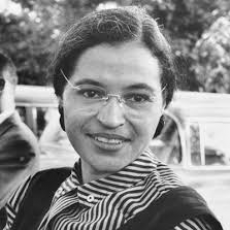
Email: ZYVC057@live.rhul.ac.uk
Total Article : 213
About Me:I'm a graduate student studying International Criminal Law and first started writing for King's News almost 4 years ago! My hobbies include reading, travelling and charity work. I cover many categories but my favourite articles to write are about mysteries of the ancient world, interesting places to visit, the Italian language and animals!

It is quite the assumption to say that one person can change the world and an even greater one to name a single person who has done so. Having said this I strongly believe Rosa Parks has earned her name under this category due to her constant struggle for civil rights and her achievements in the field which call for recognition. Rosa Parks, an Afro-American civil rights activist and seamstress, paved the way for a more humanitarian and equalitarian society so let’s meet the woman behind what the US congress believed to be the ‘mother of the modern day civil rights movement’.
Rosa Louise McCauley was born in Alabama in 1913 and, despite there being positive accounts with white people in her autobiography, she could not hide from the strong racism embedded in society. As a young child she feared the Klu Klux Klan, three movements In the US which called for a ‘purification’ of America and made African Americans their primary target of violence during the late 1800s. In 1932 Rosa married barber Raymond Parks, who was a member of the National Association for the Advancement of Coloured People (NAACP), an association which sought to provide protection against colour discrimination and to reassure racial equality was respected. Rosa was encouraged by her husband to finish high school, a rare possibility at the time as less than 7% of Afro-Americans obtained a high school diploma. In 1943, a decade after graduation, Rosa joined the Civil Rights Movement with NAACP and began her fight for equal rights as secretary.
December 1st, 1955. After a long day at work Rosa Parks got the Cleveland Avenue bus home. Once she had paid her bus fare she chose an empty seat for herself which was located in the first row of seats at the back which were reserved for people of colour. As they drove the ten seats in front of Rosa reserved for white people became full and more white people boarded on the bus. According to the city ordinance of Montgomery, people should sit within their assigned section but if all seats were filled no passenger would be required to give up their seat, although bus drivers usually did not consider this to be a valid law. By this time Rosa had still not noticed that the bus driver was James F. Blake, the same man that had left her standing in the rain when he drove the bus a year earlier. As usual the bus driver stood up and moved the sign for people of colour back four seats, so technically Rosa would be now obliged to stand up and let her seat be taken by a white person. The three people next to Rosa moved but when Rosa refused to stand up the bus driver threated to call the police. Rosa remained in her seat and was arrested. This was not only a physical act but an ideological standing, with this one move of defiance Rosa would be sending a human rights’ message which is echoed to this day.
This event gave way to the Montgomery Bus Boycott led by key figures including Martin Luther King Junior. It began when Rosa had been convicted and after many struggles it resulted in the segregation bus laws of Alabama and Montgomery to be unconstitutional. Rosa Parks’ efforts were recognised nationally when she was awarded with the NAACP’s 1979 Spingarn Medal, the Presidential Medal of Freedom, the Congressional Gold Medal, and a statue in the United States Capitol's National Statuary Hall. During the latter years of her life Rosa suffered from dementia and when she died in 2005 she became the first woman and the second non-US government official to rest at the Capitol Rotunda in Washington DC.
Some may call it stubbornness, others the strive for justice but the contribution Rosa Parks gifted to the civil rights movement is immense as she lit up the path to the abolition of racial equalities. Living in a time when racial inferiority was an everyday issue Rosa found the courage to stand up for herself and the strength to continue pursuing the matter until her rights were recognised. Would you have been one of the three people to stand up and move or would you have been a Rosa Parks, a young fighter with big ambitions and the spirit to fight for them?
IMAGE: http://s3.amazonaws.com/rapgenius/filepicker%2FkXJmeljRBCVD2Hmtvjve_rosa_parks.jpg

0 Comment:
Be the first one to comment on this article.